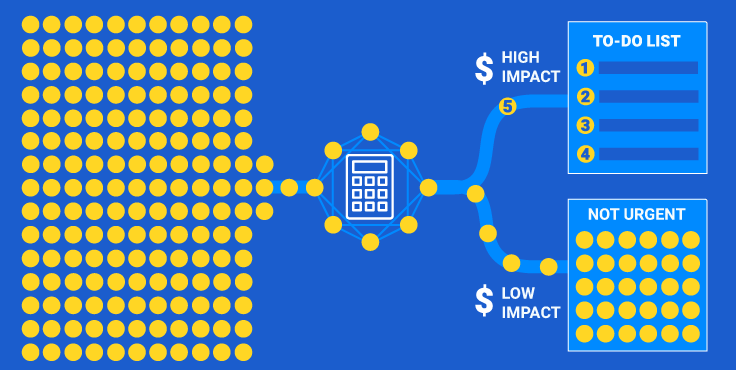Prune Deadwood From Your Paid Search Campaigns to Maximize Performance on a Limited Budget

Paid search is often one of the first places businesses look when they need to make cuts to their marketing budget. But before you start slashing your paid search budget, it’s important to take a step back and evaluate your low-level campaign assets to understand which assets are not performing and why, how performance can be improved, and which assets should be "pruned" to improve overall performance.
In this article, we’ll explore how to prune deadwood from your paid search campaigns so that more budget flows to the keywords that are actually driving results. Let's face it, a campaign's performance – whether measured in return-on-ad-spend (ROAS) for purchase transactions, cost-per-action (CPA) for lead generation, or cost-per-click (CPC) or cost-per-thousand-impressions (CPM) for awareness - is just a mathematical average of the aggregate performance of all its low-level assets. There are obvious "winners" and "losers" (keywords and search terms) hiding at the bottom of the campaign hierarchy, where data is too sparse for the ad platforms' Machine Learning algorithms to operate.
What is “deadwood” in paid search?
“Deadwood” is a term used to describe the assets in a paid search campaign that are no longer effective and need to be removed. Deadwood can refer to pesky irrelevant search terms that drag down keyword performance and need to be added as negative keywords. Deadwood can also include keywords, ad groups, or even entire campaigns that are no longer generating leads or sales at an acceptable return on investment. In an ideal world, we would try improving performance of every low-level campaign asset before eliminating it. However, the time and effort required often outweigh potential performance improvements.
Why is it important to remove deadwood from your paid search campaigns? Because deadwood negatively impacts your overall performance and wastes your budget. If you don’t regularly prune the deadwood hiding in your campaigns, it’s like putting money into a leaky sieve.
How and when should you identify deadwood in your campaigns?
To identify and trim deadwood from your campaigns, you must carefully assess the performance of individual keywords over time, in the context of business objectives and relative to peer group (also known as cohort) performance. Some keywords may have once generated high traffic but have become less relevant over time and no longer bring in a significant number of conversions. If you see a pronounced drop in results that is not associated with an expected seasonal drop, that’s a good indication that something needs to be changed or removed. Market competition may have increased for some keywords to the point that the conversions generated are prohibitively expensive. It’s important to exercise caution when pausing or removing keywords.
Tips for Pruning Deadwood Keywords With Caution:
- Start from the bottom up. Work from the lowest level of granularity: search terms. Look for irrelevant words or phrases that are triggering your ads. Add negative keywords to your campaigns to ensure that your ads are only shown to prospects who will be interested in your offering.
- Understand WHY the keyword is performing poorly. Is it because of a low click-through rate, high cost-per-click, or low conversion rate? Once you know the reason, you can make a more informed decision about whether or not to pause the keyword.
- Don’t be aspirational with your baseline performance target. The last thing you would want to do is turn off all your keywords! When pruning deadwood keywords, you want to use a baseline performance target that reflects the minimally-acceptable performance standard– the highest acceptable CPA or the rock bottom ROAS - for your business.
- Check keyword performance over consecutive short time periods. Choose a sample duration (e.g. week) and number of samples (e.g. four) that makes sense for your business. If a keyword consistently underperforms compared to its goal – as in, it failed to meet your ROAS, CPA, CPC, or CPM for the last four consecutive weeks - that keyword is a candidate for pruning. But first, apply the additional tests below.
- Check historical keyword performance over a long period. Check the keyword’s average performance over a long time period (e.g., 365 days or the lifetime of the keyword, whichever is smaller). If the keyword has performed well over the long period, leave it enabled unless a consistent downward trend is evident.
- Establish a “time allowance.” Decide how long you are willing to wait (and possibly lose money) before judging a keyword on its overall performance. Filter out keywords from the prune list if they haven’t yet exceeded that time allowance.
- Establish a “cost allowance.” for each keyword. How much are you willing to spend to experiment with a new keyword? Filter out keywords from the prune list that haven’t yet exceeded the cost allowance.
- Evaluate each keyword’s performance relative to its “peers.” Check how the keyword is performing relative to other keywords in the same campaign or in campaigns with the same objective. Only keywords in the bottom performance quartile should be put on the prune list.
- Evaluate whether the keyword is trending in the right direction. A linear regression can be used to predict whether a keyword will meet your performance goal within a certain timeframe, such as two weeks or one month. If a keyword is on track to meet your baseline performance target within that timeframe, leave it enabled.
- Hold ALL keywords accountable – even brand keywords. Several scenarios outside of your company’s control can result in unacceptable performance of your brand keywords. Examples are competitors running conquesting campaigns, bidding up the price of your keywords; or resellers offering your products at a discount. The numbers don’t lie. It may be time to give certain brand keywords a rest while you address the underlying problem or wait for market conditions to improve.
- Be honest with yourself. If a keyword is no longer aligned with your business goals, you have three choices:
- Take immediate steps to improve performance (e.g., add negative keywords, improve ad copy, improve or select a new landing page)
- Downgrade your performance expectations, if that’s possible while maintaining a healthy business.
- Let the keyword go! Set aside your emotions and pause the keyword, at least for now.
Conclusion
Of course, there's no hard and fast rule for when to pause low-performing keywords. Ultimately, the decision comes down to whether or not you think the keyword has the potential to perform well in the future. If you think the keyword has potential, then you may want to continue running it while making adjustments to your campaign assets. However, if you don't think the keyword has potential, then you may want to pause it and focus your efforts on other keywords that are performing well. The key is to regularly evaluate performance so keywords that continue to perform poorly don't continue to waste spend.
If you want a way to automate the process, take a look at Condati Quant Marketer. Quant Marketer's prescriptive analytics solution not only tells you what keywords to pause and which search terms to add as negative keywords but provides many different optimization recommendations that are prioritized by financial impact. The continuous intelligence it provides means you know what actions to focus on at anytime. No ad hoc analysis needed.




